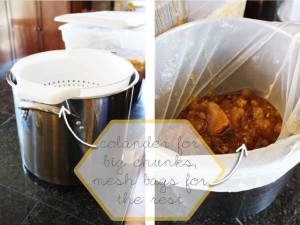Now, there’s all kinds of equipment that makes processing honey quick and easy. Most of it isn’t very fancy or expensive, but you do have to be able to find it to use it, and as luck would have it, we couldn’t find any of it! We couldn’t find the uncapping knife that makes it easy to scrape just the top layer of wax off the honeycomb. We couldn’t find the handle to the centrifuge that allows you to spin the honey out of your frames without scraping the honeycomb off. And half of our frames didn’t fit in the centrifuge anyway. So we did things the old-fashioned way!
Well we got all of that honey removed from the frames and…my husband woke up the next morning with a raging case of pneumonia! So the honey sat and sat…and sat…and sat. He was really sick, poor thing! Luckily, honey isn’t opposed to sitting around for a week or so; it’s antimicrobial (germs don’t grow in it) and doesn’t need refrigeration, plus all that sitting around lets the bees wax rise to the top, which makes for slightly easier filtering.
Lesson #7 in Backyard Farming: As in almost all areas of life, it really is most efficient if you have a plan first. Otherwise, you end up filtering your honey 4 times because you keep pouring chunks of beeswax into the honey you’ve already filtered.
Last year when we bottled honey, we ladled it into the jars. As you can imagine, that makes for a sticky kitchen! This time, we wised up and poured all of the filtered honey into the busted centrifuge, which has a handy spigot at the bottom–so it ended up being good for something! And the kitchen still ended up being ridiculously sticky, but slightly less so than it would have been if we’d used a ladle. Sometimes that’s about all you can ask for!










Oh… this hoey looks so beautiful! I love honey, my favorite is acacia honey.
Ciao.
Nevermind, I found it! 😀
I want to have a beehive at our house, but my husband is allergic to bees. For some reason he doesn’t want them around… darn!;)